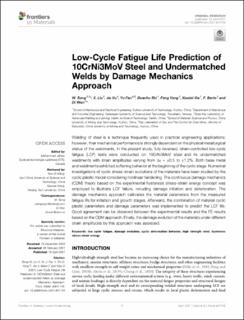| dc.contributor.author | Song, Wei | |
| dc.contributor.author | Liu, Xuesong | |
| dc.contributor.author | Xu, Jie | |
| dc.contributor.author | Fan, Yu | |
| dc.contributor.author | Shi, Duanhu | |
| dc.contributor.author | Yang, Feng | |
| dc.contributor.author | Xia, Xiaolei | |
| dc.contributor.author | Berto, Filippo | |
| dc.contributor.author | Wan, Di | |
| dc.date.accessioned | 2021-04-19T08:21:45Z | |
| dc.date.available | 2021-04-19T08:21:45Z | |
| dc.date.created | 2021-02-16T14:39:33Z | |
| dc.date.issued | 2021 | |
| dc.identifier.citation | Frontiers in Materials. 2021, 8, . | en_US |
| dc.identifier.issn | 2296-8016 | |
| dc.identifier.uri | https://hdl.handle.net/11250/2738267 | |
| dc.description.abstract | Welding of steel is a technique frequently used in practical engineering applications; however, their mechanical performance is strongly dependent on the physical metallurgical status of the weldments. In the present study, fully reversed, strain-controlled low-cycle fatigue (LCF) tests were conducted on 10CrNi3MoV steel and its undermatched weldments with strain amplitudes varying from Δε = ±0.5 to ±1.2%. Both base metal and weldments exhibited softening behavior at the beginning of the cyclic stage. Numerical investigations of cyclic stress–strain evolutions of the materials have been studied by the cyclic plastic model considering nonlinear hardening. The continuous damage mechanics (CDM) theory based on the experimental hysteresis stress–strain energy concept was employed to illustrate LCF failure, including damage initiation and deterioration. The damage mechanics approach calibrates the material parameters from the measured fatigue life for initiation and growth stages. Afterward, the combination of material cyclic plastic parameters and damage parameters was implemented to predict the LCF life. Good agreement can be observed between the experimental results and the FE results based on the CDM approach. Finally, the damage evolution of the materials under different strain amplitudes by this approach was assessed. | en_US |
| dc.language.iso | eng | en_US |
| dc.publisher | Frontiers Media | en_US |
| dc.rights | Navngivelse 4.0 Internasjonal | * |
| dc.rights.uri | http://creativecommons.org/licenses/by/4.0/deed.no | * |
| dc.title | Low cycle fatigue life prediction of 10CrNi3MoV steel and undermatched welds by damage mechanics approach | en_US |
| dc.type | Peer reviewed | en_US |
| dc.type | Journal article | en_US |
| dc.description.version | publishedVersion | en_US |
| dc.source.volume | 8 | en_US |
| dc.source.journal | Frontiers in Materials | en_US |
| dc.identifier.doi | 10.3389/fmats.2021.641145 | |
| dc.identifier.cristin | 1890456 | |
| dc.description.localcode | Copyright © 2021 Song, Liu, Xu, Fan, Shi, Yang, Xia, Berto and Wan. This is an open-access article distributed under the terms of the Creative Commons Attribution License (CC BY). The use, distribution or reproduction in other forums is permitted, provided the original author(s) and the copyright owner(s) are credited and that the original publication in this journal is cited, in accordance with accepted academic practice. No use, distribution or reproduction is permitted which does not comply with these terms. | en_US |
| dc.source.articlenumber | 641145 | en_US |
| cristin.ispublished | false | |
| cristin.fulltext | original | |
| cristin.qualitycode | 1 | |

